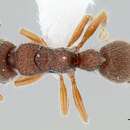en
names in breadcrumbs


Heteroponera panamensis is relatively common but inconspicuous in montane forests throughout Costa Rica. It occurs in closed-canopy forest, near ground level. The small colonies may be in dead sticks on the ground, but more often are in chambers in live plant stems. These may be irregular chambers and necrotic areas in stems that are not usually hollow, or preformed chambers in myrmecophytes such as Cecropia. When the latter, they occupy single chambers in saplings, when the plant has not been dominated by one of its usual associates (e.g. Azteca in the case of Cecropia). Workers occasionally appear in leaf litter samples (Winkler samples) from the forest floor.
Regular winged queens appear to be rare in this species. I have dissected numerous nests and never found a dealate queen or new alate queens. However, I do have a normal alate queen collected as a stray. Close inspection of nest populations reveals what may be ergatoid queens. They have a single, very small ocellus interrupting the median carina on the frons. Also, they appear slightly larger than the average worker. The mesosoma is a bit more robust, and the petiole in profile is thicker, with the posterior margin less concave than in workers. Several other species in the genus are known to have wingless ergatoid queens instead of normal winged queens (Brown 1958).
Costa Rica, Panama, Colombia. Costa Rica: montane forests throughout, down to about 500m elevation.
Taxonomic history
Combination in Acanthoponera: Emery, 1911e PDF: 36.Combination in Heteroponera (Anacanthoponera): Wheeler, 1923f PDF: 187.Combination in Heteroponera: Brown, 1958g PDF: 196.Raised to species: Brown, 1958g PDF: 196.See also: Brown, 1958g PDF: 259; Kempf, 1962a PDF: 40.
Heteroponera panamensis is a species of ant in the genus Heteroponera. Endemic to Costa Rica and Panama, It was described by Forel in 1899.[1]
Heteroponera panamensis is a species of ant in the genus Heteroponera. Endemic to Costa Rica and Panama, It was described by Forel in 1899.